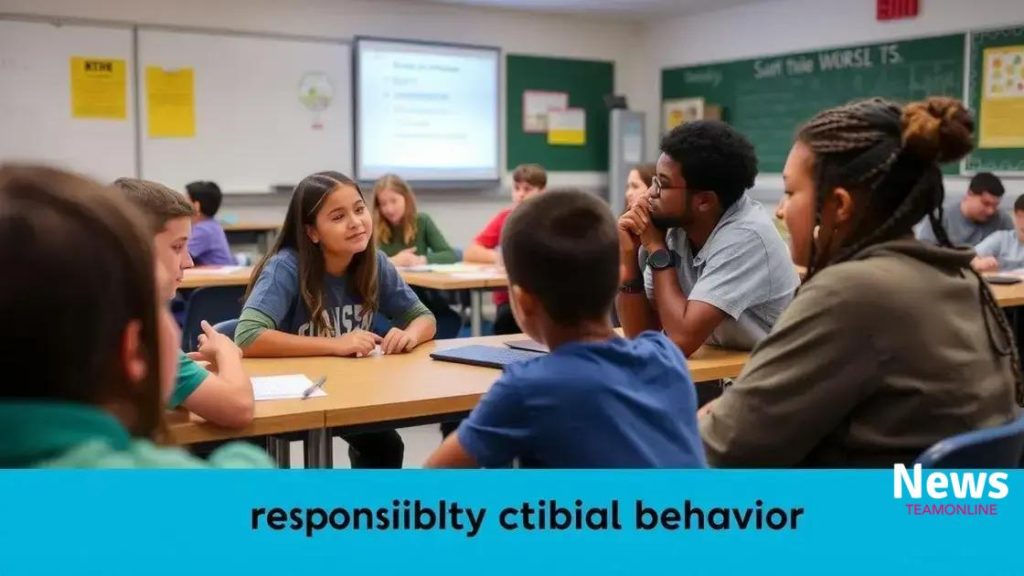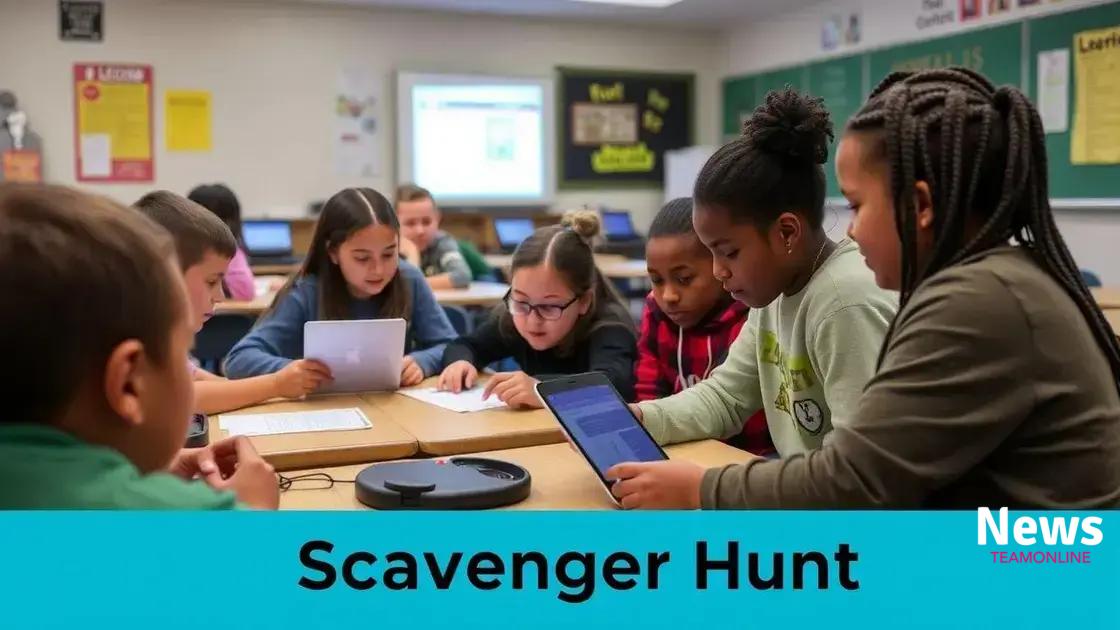Curriculum to teach responsible digital behavior in schools

A curriculum to teach responsible digital behavior includes practical activities, parental involvement, and continuous assessment, aiming to empower students as safe and respectful digital citizens.
Curriculum to teach responsible digital behavior is vital in today’s online world. You might wonder how schools can empower students to navigate their digital lives safely and responsibly. Let’s dive into some essential strategies and insights that can transform education.
Understanding digital behavior and its impact
Understanding digital behavior is crucial in today’s technology-driven world. It shapes how individuals interact online and influences their experiences. Many people are unaware of the consequences their actions can have, both positively and negatively.
What is Digital Behavior?
Digital behavior refers to how users engage with online platforms, content, and each other. It includes actions such as searching for information, sharing posts, and interacting in online communities. For example, when students participate in social media, they develop a digital footprint that can affect their reputation.
Impact of Digital Behavior
The impact of digital behavior can be profound. It can influence mental health, academic performance, and social relationships. Many students may not realize the long-term effects of their online presence. This makes teaching responsible digital behavior essential.
- Increased awareness of online safety.
- Better communication skills.
- Enhanced problem-solving abilities.
To navigate the challenges of the digital age, it is important for students to understand their digital behavior. Awareness leads to improved choices online, fostering a safer digital environment.
For example, encouraging critical thinking about the content they share can help them recognize misinformation. It’s not just about what they post but also about understanding how their actions affect others.
Additionally, promoting empathy online can support healthy interactions. As students learn about their digital behavior, they will be better equipped to manage their online relationships.
Incorporating digital behavior education into the curriculum can profoundly change how students engage with technology.
Key components of a responsible digital curriculum
Key components of a responsible digital curriculum play a significant role in shaping students’ digital experiences. Understanding these components helps educators create effective learning environments.
Awareness and Education
First, a solid digital curriculum must focus on awareness. Educators should introduce topics such as digital footprints and online privacy. By teaching students about their online presence, they can better understand the consequences of their actions.
Critical Thinking Skills
Another crucial aspect is encouraging critical thinking. Students should learn to evaluate sources and challenge misinformation. This skill set is vital, as it enables them to navigate the vast information available online effectively.
- Teach strategies for assessing source credibility.
- Discuss the impact of biased information.
- Practice online research techniques.
This kind of training allows students to approach information with a discerning mindset. As they analyze various viewpoints, they develop a deeper understanding of different perspectives.
Incorporating hands-on activities can enhance these lessons. For example, using role-playing exercises allows students to experience real-world scenarios where online behavior matters. This interactive approach promotes retention and understanding.
Digital Citizenship
Equally important is the focus on digital citizenship. This involves teaching students how to interact respectfully and responsibly in online spaces. Engaging in discussions about kindness and empathy can foster a healthy online community.
Promoting positive behavior online contributes to a supportive environment. Lessons on recognizing and reporting cyberbullying can empower students to act responsibly and help others.
Finally, collaboration between parents and educators strengthens a digital curriculum. By involving parents in discussions about technology use, schools can create consistent messaging about responsible online behavior.
Practical activities for engaging students

Engaging students through practical activities is essential to teaching responsible digital behavior. These activities help reinforce what students learn and make the concepts more relatable and memorable.
Interactive Workshops
One effective approach is to organize interactive workshops. These sessions can cover topics like cyberbullying, online privacy, and digital footprints. For instance, role-playing scenarios can allow students to experience the consequences of their online actions firsthand.
Group Discussions
Group discussions are also beneficial. By encouraging students to share their thoughts on real-life digital issues, you promote critical thinking. For example, discussing the impact of social media on friendships can help them reflect on their experiences.
- Hold debates on online privacy.
- Encourage brainstorming sessions on solutions to cyberbullying.
- Facilitate conversations about news and misinformation.
In addition to workshops and discussions, hands-on projects can immerse students in technology. Creating a digital presentation on a topic related to online safety allows students to apply their knowledge creatively. They can explore various aspects of the topic and engage peers through their presentations.
Another practical activity is participating in a digital scavenger hunt. This activity encourages students to search for reliable sources of information online, promoting their ability to identify trustworthy websites. Through this engaging method, they learn to navigate the internet wisely.
Parent Involvement
Involving parents in these activities can enhance their effectiveness. Hosting parent-student evenings to discuss digital behavior helps create a supportive environment at home. When families engage, the lessons learned at school can be reinforced.
By using a variety of practical activities, educators foster a deeper understanding of responsible digital behavior.
Involving parents and community in digital education
Involving parents and the community in digital education is essential for promoting responsible digital behavior among students. When families participate in this process, it creates a stronger support system for students.
Parent Workshops
Organizing parent workshops can be a great way to educate families about digital challenges. These workshops can cover topics such as safe online practices, understanding social media, and recognizing signs of cyberbullying. This knowledge empowers parents to guide their children effectively.
Community Engagement
Engaging the community adds another layer of support. Schools can collaborate with local organizations to host events focused on digital literacy. For instance, community seminars can cover topics like internet safety and the effects of screen time.
- Invite experts to speak on digital issues.
- Create resource materials for families.
- Encourage local businesses to participate in digital education initiatives.
By involving community resources, schools enhance their educational efforts. Students benefit when their learning extends beyond the classroom and into the community.
Encouraging open communication between teachers and parents can also create a supportive network. Regular newsletters or updates about digital education initiatives help keep families informed. Parents can share experiences and strategies, fostering a collaborative approach to online safety.
Collaborative Projects
Creating collaborative projects that involve parents and students can spark interest in digital education. These projects may include developing a family media plan, where families outline their screen time guidelines together. This initiative not only promotes responsible device use but also strengthens family bonds.
When parents and the community are involved in digital education, they help reinforce the positive behaviors that students learn in school. This partnership strengthens the commitment to cultivating a safe and respectful digital environment.
Assessing student progress in digital behavior
Assessing student progress in digital behavior is key to understanding their development and effectiveness of the curriculum. Regular assessment helps identify areas where students excel and areas that need improvement.
Setting Clear Goals
First, it’s important to establish clear goals for what responsible digital behavior looks like. These goals can serve as benchmarks for evaluation. For example, students should understand the importance of online privacy and how to protect their personal information. By outlining expectations, teachers provide a roadmap for assessment.
Using Multiple Assessment Methods
Employing multiple assessment methods offers comprehensive insights into student progress. Teachers can use surveys, formal tests, and observation to evaluate understanding. While quizzes can test knowledge on digital safety, surveys can gather students’ feelings about using technology responsibly.
- Use checklists to track student participation in digital activities.
- Integrate peer assessments to encourage collaboration.
- Collect feedback from parents on students’ online behavior at home.
This feedback helps create a broader perspective on student behavior. Observing students in group projects allows teachers to see how well they collaborate online and communicate with peers.
In addition, implementing self-assessments encourages students to reflect on their digital habits. They can evaluate their attitudes towards technology and identify areas for growth. This reflection builds self-awareness and responsibility.
Continuous Monitoring and Feedback
Continuous monitoring is essential. Regular check-ins help teachers adapt lessons based on student needs. Grades should reflect not only knowledge but also progress in digital citizenship.
Providing constructive feedback is vital. Recognizing improvements motivates students and reinforces positive behaviors. Highlighting specific actions that demonstrate responsible use of technology helps students understand what they are doing right.
Lastly, adjusting the curriculum based on assessment results can enhance learning. Tailoring instruction to meet student needs increases engagement. Focusing on areas where students struggle ensures that they gain essential skills.
FAQ – Frequently Asked Questions about Responsible Digital Behavior Education
Why is teaching responsible digital behavior important for students?
Teaching responsible digital behavior helps students make safe and ethical choices online, promoting positive interactions and protecting their privacy.
How can parents get involved in their child’s digital education?
Parents can participate by attending workshops, engaging in discussions with teachers, and supporting digital learning activities at home.
What types of activities can engage students in digital behavior education?
Interactive workshops, group discussions, and hands-on projects are effective ways to engage students and reinforce responsible digital behaviors.
How can schools assess student progress in digital behavior?
Schools can assess progress through various methods, including surveys, observation, and self-assessments, helping to track students’ understanding and improvements.





